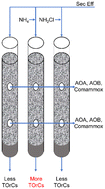The role of ammonia oxidizing microorganisms in biofiltration for the removal of trace organic compounds in secondary wastewater effluent†
Abstract
Due to their uncertain public health impacts, the occurrence of some trace organic compounds (TOrCs) in domestic wastewater can be problematic for potable reuse systems seeking to avoid advanced treatment with reverse osmosis. By employing biofiltration, some TOrC attenuation may be achieved through cometabolic biotransformation by ammonia oxidizing microorganisms (AOMs). These include ammonia oxidizing archaea (AOA), ammonia oxidizing bacteria (AOB), and complete ammonia oxidizing (comammox) bacteria. This research aimed to investigate the role of AOMs in TOrC biotransformation by evaluating pilot-scale biologically active filters (BAFs) with aged activated carbon media. Three parallel columns were fed with fully nitrified secondary effluent (1) without supplementation, (2) supplemented with ammonia at 2 mg-N per L, or (3) dosed with chloramine at 0.3 mg-Cl2 per L. For highly biodegradable indicator TOrCs (caffeine, ibuprofen, and naproxen) that were spiked into the feeds at ∼500 ng L−1, the control and chloramine-dosed BAFs performed similarly and achieved an average removal of 76 ± 9%, whereas the ammonia-dosed BAF achieved only 55 ± 20%. With ammonia dosing, AOB dominated the AOM community, comprising 64% and 44% of the AOMs at the top (36 cm) and bottom (72 cm) sampling depths, respectively. In contrast, the control and chloramine-dosed filters were dominated by comammox bacteria, which generally comprised >80% of the AOM community. Our results suggest that nitrifying microorganisms may play an important role in TOrC biotransformation, but ammonia-rich environments may adversely impact important cometabolic pathways. Thus, non- or partially nitrified systems or short-term upsets in secondary biological treatment could lead to elevated concentrations of ammonia and biodegradable TOrCs in tertiary biofilter effluents. On the other hand, the selection of comammox bacteria in low-ammonia environments could lead to enhanced TOrC biotransformation.

- This article is part of the themed collection: Environmental Science: Water Research & Technology Recent HOT Articles


 Please wait while we load your content...
Please wait while we load your content...